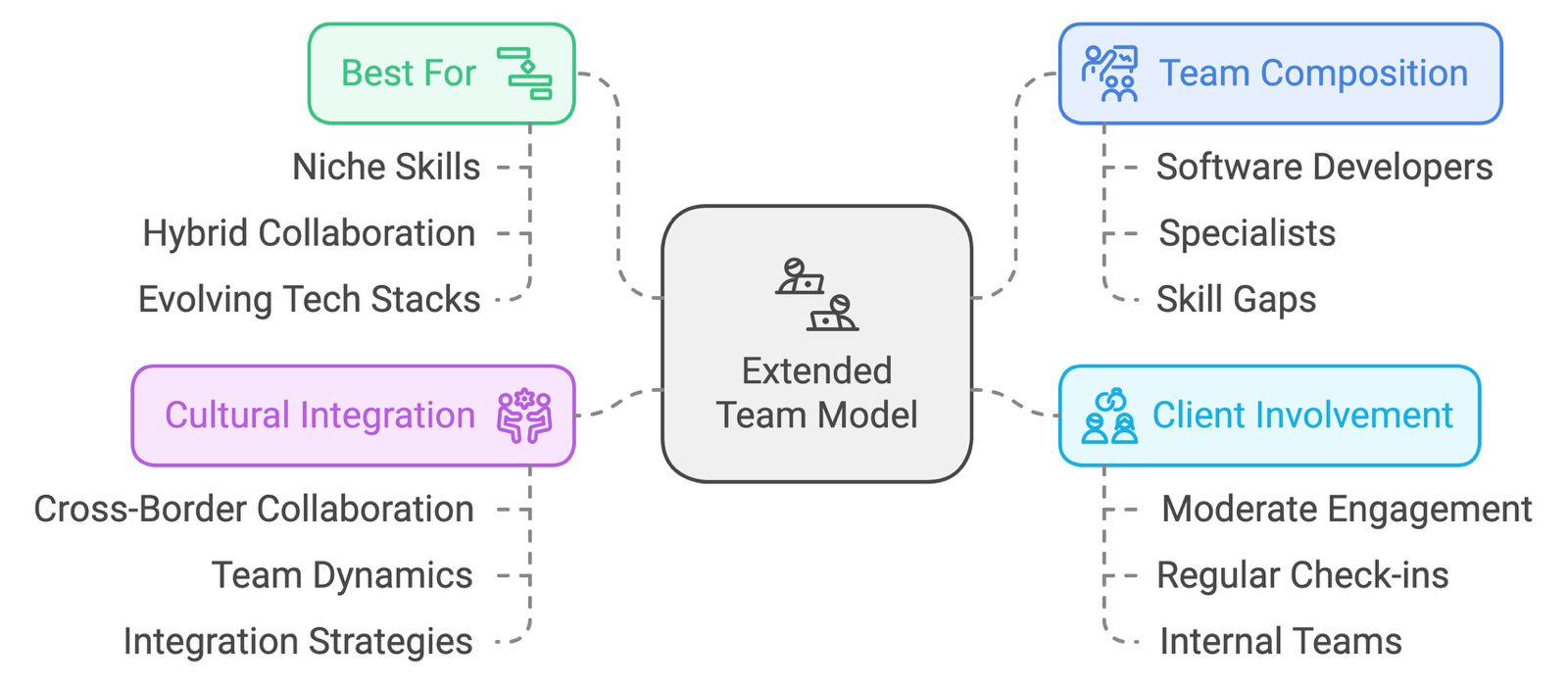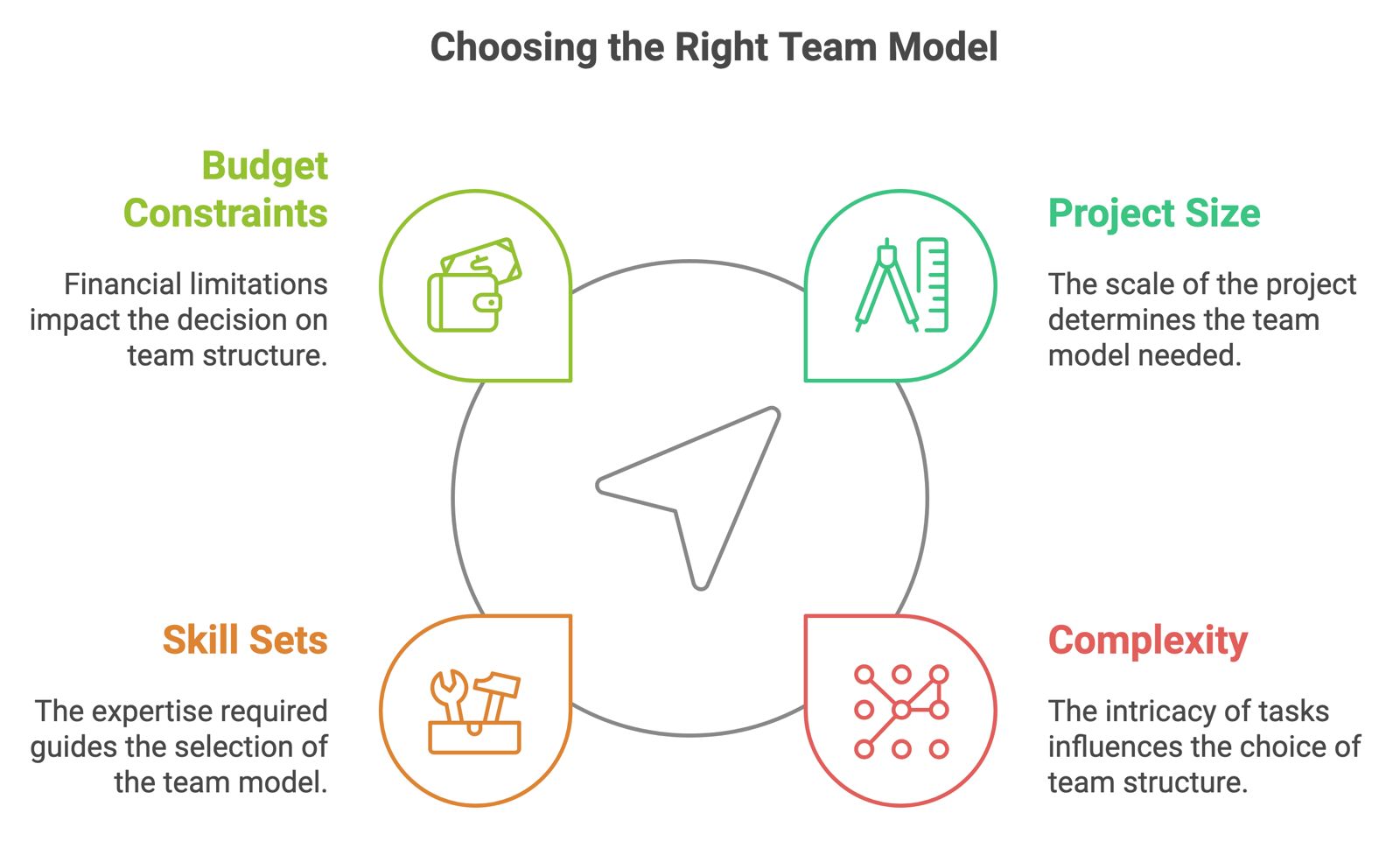
Offshore development has become a strategic approach for companies across the globe, offering benefits like cost efficiency, access to a global talent pool, and flexibility. But the effectiveness of offshore teams largely depends on choosing the right development team structure for the project. This guide explores different team structures, their applications for various project types, and best practices for aligning these structures with project goals.
Introduction to Offshore Development Team Structures
The structure of an offshore development team can significantly impact a project’s success. A well-chosen team model aligns with project goals, the client's level of involvement, and specific project challenges, enabling smoother collaboration and timely delivery.
Why Offshore Development Structures Matter
- Cost Efficiency: Choosing the right structure can lower overhead costs by up to 60% in comparison to in-house teams (Statista, 2023).
- Talent Utilization: Leveraging specialized skills across borders is often achieved through proper structuring, especially for complex software projects.
- Flexibility and Scalability: Different team structures offer varying degrees of flexibility, which is crucial for scalable software projects.
Key Types of Offshore Development Team Structures
Different offshore team structures work better for distinct project requirements. Below are some of the most common structures and their ideal applications.
1. Dedicated Team Model

The dedicated team model is ideal for long-term projects that require continuous development and strong alignment with the client’s vision. This model offers flexibility, enabling teams to adjust based on changing project needs.
- Best for: Large-scale projects, SaaS product development, complex enterprise software
- Team Composition: Project managers, software engineers, quality analysts, UI/UX designers
- Client Involvement: High; client typically works closely with the team to ensure alignment with business goals.
- Example: For a SaaS company building a large-scale platform, a dedicated team structure enables ongoing development and support.
For businesses wondering when it’s time to expand their teams, check out 5 Signs You Need to Scale Your Development Team for helpful insights.
2. Extended Team Model

The extended team model functions as an extension of an in-house team, providing additional resources and expertise without the need to hire locally. This model is especially effective for companies looking to add specialized talent.
- Best for: Projects requiring niche skills, hybrid in-house/offshore collaboration, rapidly evolving tech stacks.
- Team Composition: Varies; typically software developers and specialists that fill specific skill gaps.
- Client Involvement: Moderate to high, often involving regular check-ins with internal teams.
- Example: A U.S.-based company expanding its platform with a machine learning feature might add ML experts through an offshore extended team.
Since extended teams work closely with in-house staff, Cultural Integration in Distributed Teams is crucial for fostering collaboration across borders.
3. Project-Based Team Model

The project-based model is tailored for short-term or one-off projects where the team is assembled specifically to complete a defined scope within a set timeframe.
- Best for: Short-term projects, product MVPs, quick development needs
- Team Composition: Project manager, developers, testers; the team disbands after project completion.
- Client Involvement: Low; the offshore team often works autonomously based on clearly defined deliverables.
- Example: A retail business looking to develop an e-commerce app might opt for a project-based team for initial development.
Selecting the Right Structure Based on Project Type

Understanding project requirements is key to selecting the most suitable offshore team structure. Below are factors to consider when matching a team structure to a project.
1. Project Size and Complexity
- Large-Scale Projects: Often require a dedicated team for sustained development and support.
- Small to Medium Projects: A project-based team might be the most efficient, especially if the project has a clear end date.
2. Required Skill Sets
- Niche Skills: For projects requiring specialized skills (e.g., AI, DevOps), an extended team model can be beneficial.
- Generalist Skills: For projects that rely on broad development skills, a project-based team is usually sufficient.
3. Budget Constraints
- High Budget: If budget isn’t a primary constraint, a dedicated team offers flexibility and alignment with long-term goals.
- Limited Budget: For cost efficiency, the project-based model works well for straightforward, short-term projects.
For more on cost management, see How to Effectively Communicate with Your Offshore Team for strategies on minimizing overhead.
4. Desired Speed of Execution
- High-Speed Requirements: A project-based team can be quickly mobilized, ideal for accelerated timelines.
- Long-Term Flexibility: A dedicated team allows for flexible, iterative development cycles.
Common Challenges and How to Address Them
Implementing offshore development teams introduces some unique challenges. Here’s how to address them for each team structure type.
Communication Challenges
- Dedicated Teams: Implement regular sprint reviews to align goals and ensure visibility.
- Extended Teams: Use collaborative tools like Slack and JIRA for seamless communication with in-house teams.
- Project-Based Teams: Set clear timelines and milestones from the outset to avoid delays.
Managing Cultural Differences
- Solution: Host cultural awareness sessions to foster cultural integration in distributed teams, building rapport and minimizing misunderstandings.
Ensuring Data Security
- Solution: Enforce strict data protection policies and ensure compliance with international regulations like GDPR and CCPA.
Data security is critical, especially with offshore teams. Learn more in our guide on Securing Your Offshore Development Process.
Productivity Tracking
- Solution: Utilize productivity tools and implement Key Performance Indicators (KPIs) that are mutually agreed upon and revisited regularly.
Key Statistics on Offshore Development Team Performance
Statistics highlight the impact of offshore development team models on business outcomes:

- 85% of companies report a reduction in development costs after adopting an offshore model (Deloitte, 2022).

- Organizations that use dedicated offshore teams experience a 25% faster project completion rate on average (Forbes, 2023).
- Companies leveraging extended teams report a 30% increase in specialized project delivery (Gartner, 2023).
When to Consider Offshore Development Teams for Your Business
Determining when to leverage offshore development teams can be a strategic decision based on project goals and resource availability.
- Rapidly Growing Businesses: Offshore teams offer a cost-effective and scalable solution to meet rising demand.
- Projects Requiring Diverse Skill Sets: Offshore teams provide access to specialized skills that may be scarce or costly to hire locally.
- Businesses with Tight Timelines: Offshore teams can quickly scale up to meet urgent project timelines without overwhelming internal resources.
For more on where the industry is heading, read about the Future of Global Software Development: Trends and Strategies.
How AquSag Technologies Supports Diverse Offshore Development Needs
At AquSag Technologies, we specialize in assembling customized offshore development teams aligned with specific business goals and project requirements. With 12+ years of experience in building dedicated, extended, and project-based offshore teams, we understand the nuances of offshore collaboration, communication, and productivity.
Our services include:
- Flexible Team Structures: Choose from dedicated, extended, or project-based models tailored to your unique needs.
- Diverse Skill Sets: Access top-tier talent in fields ranging from software engineering and DevOps to AI and data security.
- Proven Track Record: With clients like Coca-Cola and ServiceNow, we bring expertise and reliability to every project.
If
you’re ready to enhance your offshore development team structure or
need expert guidance, contact AquSag Technologies today to learn how we
can support your next project.
Unlocking the power of global talent - Offshore Development Team Structures
Conclusion
Choosing the right offshore development team structure is essential for optimizing project outcomes. By understanding the nuances of each model and aligning team structures with project goals, businesses can maximize their offshore development investments. Whether your project requires a dedicated team for long-term goals, an extended team for specific skill gaps, or a project-based team for quick delivery, the right structure will pave the way for success.
For more details or a consultation, reach out to AquSag Technologies.